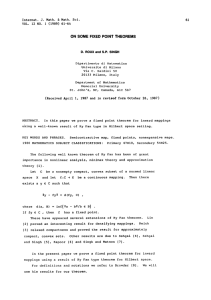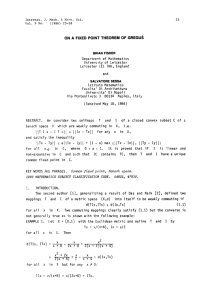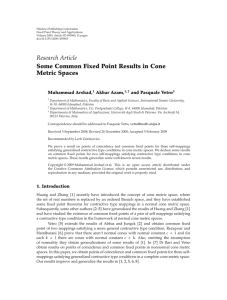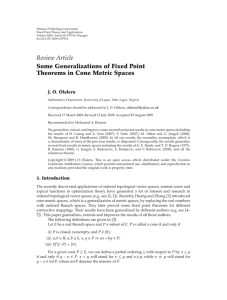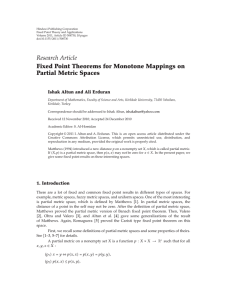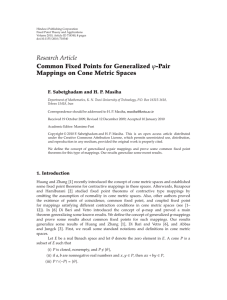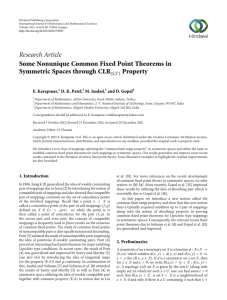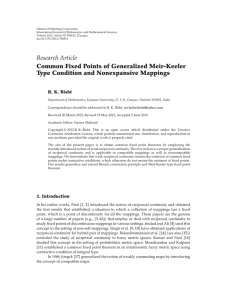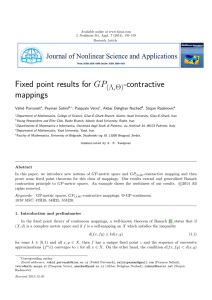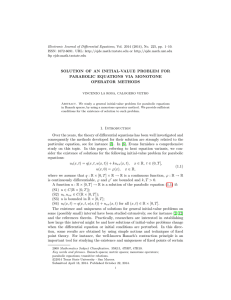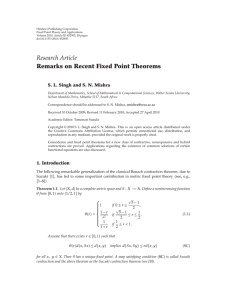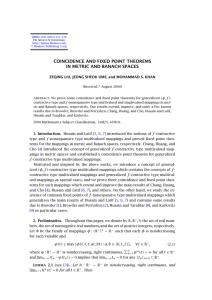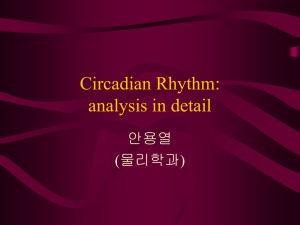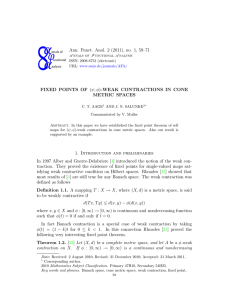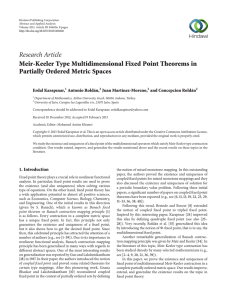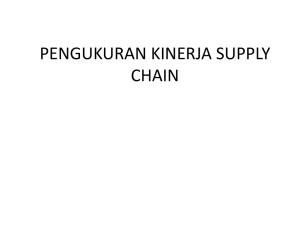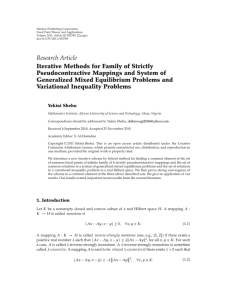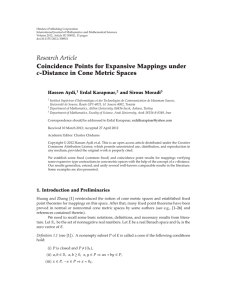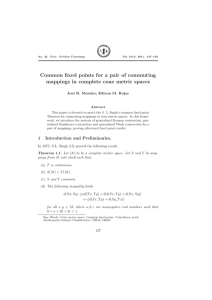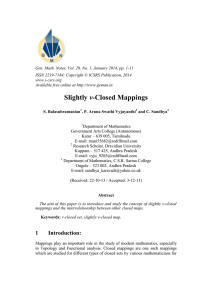MULTI-VALUED FIXED COMPATIBLE SINGLE-VALUED
advertisement
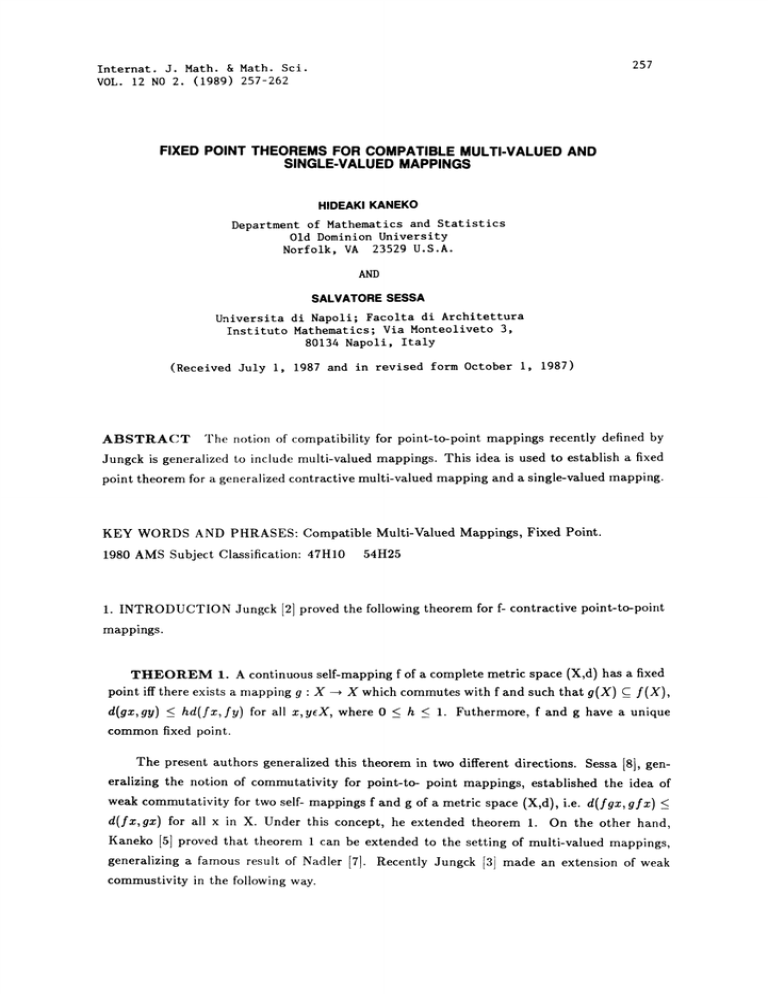
257
Internat. J. Math. & Math. Sci.
VOL. 12 NO 2. (1989) 257-262
FIXED POINT THEOREMS FOR COMPATIBLE MULTI-VALUED AND
SINGLE-VALUED MAPPINGS
HIDEAKI KANEKO
Department of Mathematics and Statistics
Old Dominion University
Norfolk, VA 23529 U.S.A.
AND
SALVATORE SESSA
Universita di Napoli; Facolta di Architettura
Instituto Mathematics; Via Monteoliveto 3,
80134 Napoli, Italy
(Received July I, 1987 and in revised form October I, 1987)
ABSTRACT The notion of compatibility for point-to-point mappings recently defined by
Jungck is generalized to include multi-valued mappings. This idea is used to establish a fixed
point theorem for a generalized contractive multi-valued mapping and a single-valued napping.
KEY WORDS AND PHRASES: Compatible Multi-Valued Mappings, Fixed Point.
1980 AMS Subject Classification: 47H10
1.
54H25
INTRODUCTION Jungck [2] proved the following theorem for f- contractive point-to-point
mappings.
THEOREM 1. A continuous self-mapping f of a complete metric space (X,d) has a fixed
point iff there exists a mapping g X
X which commutes with f and such that 9(X) C_ f(X),
d(gx, gy) < hd(fx, fy) for all x, yeX, where
0
< h<
1. Futhermore, f and g have a unique
common fixed point.
The present authors generalized this theorem in two different directions. Sessa [8], generalizing the notion of commutativity for point-to- point mappings, established the idea of
weak commutativity for two self- mappings f and g of a metric space (X,d), i.e. d(fgx, gfx) <
d(fx, gx) for all x in X. Under this concept, he extended theorem 1. On the other hand,
Kaneko [5] proved that theorem can be extended to the setting of multi-valued mappings,
generalizing a famous result of Nadler [7]. Recently Jungck [3] made an extension of weak
commustivity in the following way.
258
H. KANEKO AND S. SESSA
DEFINITION 1. Two self-mappings f and g of metric space (X,d) are compatible iff
for some point
0 whenever xn is a sequence in X such that fxn
t,gx,,
d(fgxn,gfxn)
tinX.
It can be seen that two weakly commuting mappings are compatible but the converse is
false. Examples supporting this fact can be found in [3].
The purpose of this paper is to extend the definition of compatibility to include multivalued mappings.
CB(X) the family of all closed bounded
subsets of X. Let H be the Hausdorff metric on CB(X) induced by d, i.e.
H(A,B) max {supd(x,B) xeA,supd(x,A) xeB}
for all A,B in CB(X), where d(x,A) inf{d(x,y): yeA}. It is well known [10] that (CB(X),H)
is a metric space. It is indeed a complete metric space in the event that (X,d) is also a complete
2. RESULTS Let
(X,d) be
a metric space and
metric space.
DEFINITION 2. The mappings f X
fTxeCB(X) for all xeX and H(Tfx,, fTxn)
Txn MeCB(X) and f xn teM.
X and T X
CB(X)
are compatible iff
0 whenever x, is a sequence in
X such that
Definition 2 extends definition 1 above. We are now in a position to prove our results.
Theorem 2. Let
(X,d)
be a complete metric space, f" X
compatible continuous mappings such that T(X) C_ f(X) and
(1)
H(Tx, Ty) <_
hmax
for all x,y in X, where 0
_<
{ d(fx,
X and T" X
CB(X)
be
l[d(fx, Ty)+d(fy Tx)]}
fy),d(fx, Tx),d(fy, Ty),-
h < 1. Then there exists a point teX such that
fteTt.
Proof We draw inspiration from [6]. Let xoeX be arbitrary and choose x leX such that
f xleTxo. This is possible since Txo C_ f(X). If h O, then d(f xTx) <_ H(Txo, Tx) O, i.e.
> 1, by the definition
/xeTxl since Txl is closed. Now assume that h > 0 and for k
<_
kg(Tx,Txo) (this is not generally
of H, there exists a point yeTx such that d(y,fxl)
true if k _< 1 as it is seen in [7, remark at p. 480]). Since Tx C_ f(X), let xeX be such that
y
fx2. In general, if x, has been selected, choose xn+leX so that yn fx,+leTxn and
d(yn,fxn) <_ kH(Txn, Txn_) for each n _> 1. Using (1), we have that
d(f xn, f xn+l)
h
_
kH(Txn_I,TX,)
<_ V/-max d(fxn-l,fxn),-[d(fxn-,fx,) + d(fxn, fxn+)]
<_
V/-max{d(fz,.,_,fz,),d(fx.,fxn+)}
259
FIXED POINT THEOREMS FOR GENERALIZED MAPPINGS
i.e.
d(fx,,fx,+,) <_ v/-ftd(fx,,fx,_,) for each
< 1, this shows that {fx,} is
n. Since
a
Cauchy sequence, hence it coverges to some point rex using the completeness of X. Furthermore, the above inequalities also show that H(Tx,,_I,TX,) < hd(fx,_,,fx,,). Since
is Cauchy, this must imply that {Tx,} is a Cauchy sequence in the complete metric space
(CB(X),H). Now let Tz, MeCB(X). Thus
d(t,M) < d(t, f z,) + d(f z,,M)
< d(t, fxn) + H(Txn_I,M)
0
as
n
03.
M is closed, teM and the compatibility of f and T implies that H(Tfx,, fTz,,)
03. This along with the continuities of f and T imply that
Since
n
d(ft,Tt) < d(ft, ffx,+l) + d(ffxn+x,Tt)
< d(ft, ffx,,+l)+ H(fTx,,Tt)
< d(ft, ffx,+l) + H(fTx,,Tfx,) + H(Tfx,,Tt)
as n
03,
i.e.
fteTt
since Tt is closed.
0 as
0
Q.E.D.
Remark 1. A nonempty subset S of X is proximinal if, for each xeX, there exists a point
d(x, S). Let PB(X) be the family of all bounded proximinal subsets of
X. If T X PB(X), then the interative process {y,,} in the above proof can be simplified
in the following way: if x, has been selected, let x,+leX be such that y,t
fx,+leTxn
yes such that d(x, y)
and d(fx,,y,)
d(fx,Tx,). Note that an interation scheme of Smithson [9], where Wx is
compact (hence proximinal) for all xeX, is included here. Since a proximinal set is closed, we
have PB(X) C_ CB(X). The results of [4] and [5] follow as corollaries.
f X X and T X
PB(X) be continuous mappings such that fTxePB(X) and H(Tfx, fTx) < d(fx, Tx) for all
xeX. If (1) is satisfied for all x,y in X, 0 <_ h < 1, and T(X) C_ f(X), then there exists reX
such that fteTt.
COROLLARY 1. Let
(X,d)
be a complete metric space,
COROLLARY 2. Let (X,d) be a complete metric space, T X
CB(X) and f be a
H(Tx, Ty) < hd(fx, fy) and for all x,y in X, where
f(X), then there exists teX such that fteTt.
continuous self-mapping of X such that
0
< h < 1 and Tfx
fTx.
If
T(X) C_
Note that the continuity of implies the continuity of T in corollary 2. The following example
shows theorem 2 is indeed a proper generalization over corollaries 1 and 2.
EXAMPLE Let X [1, 03) be endowed with the Euclidean metric d. Let fx 2x 4and Tx
[1, x 2] for each x > 1. W and f are clearly continuous and T(X) f(X) X.
Since fx,t
1 and Tx,
{1} iff x, 1, H(fTx,Tfx,) 2(x 1) 0 iff xn 1, fTx
H. KANEKO AND S. SESSA
260
[1,(2z4-1) 2] for all z >_ 1, fand T are compatible. Since H(Tz, Ty) =l z2-Y <- 21z2-Y II
z2 + y2 /2 d(fz, fy)/2, all the conditions of theorem 2 hold with h
but the above
,
corollaries are not applicable since f and T do not weakly commute
commute either.
In the sequel,
2.2
(for
2),
x
hence do not
we use the following lemma which is a slight generalization of proposition
(part 1) of [3].
LEMMA. Let T" X
T f w.
CB(X)
and
f X
X be compatible. If fweTw for some weX,
then f Tw
PROOF. Let z, w for eachn. Then f x,
if fweTw, then H(fTw, Tfw)
H(fTx,,Tfxn)
have fTw T f w.
In order to obtain
[4]
and
a
fw
fw
and
Tzn
0 by the compatibility.
M Tw. Hence
Hence we must
Q.E.D.
as those given in
assumptions
additional
fixed point result, we need
[5].
THEOREM 3. Let f and T have the same meanings as in theorem 2. Assume also that
(i) f x -# f2x implies f x Tx or (ii) f xeTx implies that fnx z for some
zeX. Then f and T have a common fixed point in X.
for each xeX either
PROOF. By Theorem 2, fteTt for some teX and fTt Tft by Lemma. Assuming (i),
ft f2tefTt T ft. Assuming (ii), it is clear that fz z by the continuity of
f. We claim that fnteTfn-lt for each n. To see this, we have that fzt fftefTt Tft. By
lemma (w ft), f3t f f2tefTft Tf2t. Repeating this argument, we obtain fnteTfn-t
and the continuity of T implies that
we deduce that
d(z, Tz) < d(z, fnt) + d(fnt, Tz) < d(z, fnt) + H(Tfn-,Tz)
O,
i.e. zeTz since Tz is closed. Hence z is a common fixed point of f and T.
REMARK
Q.E.D.
2.
Simple examples prove that the conditions "T(X) C_ f(X)" and the
compatibility of f and T are necessary in theorem 2. Unfortunately, it is not yet known if
the continuity of both mappings f and T is necessary in theorem 2. However in the case that
f and T are single-valued mappings, it suffices only the continuity of at least one of them.
Moreover, the inequality (1) can be weakened as it is proved in the following results, which
extends theorem 2.1 of [1].
THEOREM
4.
Let (X,d) be a complete metric space and f,T
X
X be two
(def.1) such that T(X) C_ f(X) and
d(Tx, Ty) < Hmax{d(fx, fy),d(fx, Tx),d(fy, Ty),d(fx, Ty),d(fy, Tx)}
compatible mappings
(2)
for-all x,y in X, where 0 < h < 1. If one of f or T is continuous, then there exists a unique
common fixed point of f and T.
FIXED POINT THEOREMS FOR GENERALIZED MAPPINGS
261
PROOF. As in [1], it is seen that the sequence {Txn} where Tx,., fxn+l for each n, is
Cauchy sequence. Hence it converges to some point zeX. If T is continuous, then T 2xn
Tz
and Tfx=
Tz. Since d(fTx,, Tfx,) 0 by compatibility, fTx, Tz, hence using (2),
a
d(T 2x,,,, Tx,) < hmax{d(fTx,,fx,.,),d(fTx,.,,T2x,),d(fxn, Txn),
d(fTx,, Tx,.,), d(f x,, T x,)}
which implies, as n
exists a point
, that d(z,Tz) < hd(z,Tz),
z’ such that z
Tz
fz’
and using
(2)
i.e.
Tz=z. Since T(X) C_ f(X), there
again,
d(T2x,.,,Tz ’) < hmax {d(fTx,.,,z),d(fTx,.,,T2x),d(z, Tz’),d(fTx,.,,Tz’),d(z, T2x,.,))
As n
oo, we deduce that
d(z, Tz’) <_ hd(z, Tz’),
i.e.
z
Tz’
fz’
and by Lemma,
fTz’ Tf z’ Tz z.
A similar proof can be made if we assume the continuity of f instead of T. The uniqueness
follows easily from (2).
Q.E.D.
fz
REMARK 3. Note that our proof is different from that of [1], in which it is proved that
fz Tz is the unique fixed point (only if f is continuous). In this paper, it is just the case
that f z Tz z.
REMARK
fx
4. If neither
T
nor f is continuous, e.g.
X
[0,11, TO
1/4, f0
for x # 0, theorem 3 fails. Similar remarks can be made on the results of
1/2,Tx
[8]
ACKNOWLEDGEMENT: The authors would like to thank a referee for suggesting
the formulation of definition 2 in its present form.
REFERENCES
1.
K.M. Das and K.V. Naik, Common fixed point theorems for commuting
maps on a metric space, Proc. Amer. Math. Soc. 7__7 (1979), 369-373.
2. G. Jungck, Commuting mappings and fixed points, Amer. Math.
(1976), 261-263.
Monthly
3. G. Jungck, Compatible mappings and common fixed, points, Internat.
J. Math. & Math. Sci. 9 (1986), 771-779.
4.
H. Kaneko, Single-valued and multi-valued f-contractions, Boll. Un.
Mat. Ital. 6 4-.._A (1985), 29-33.
5. H. Kaneko, A common fixed point of weakly commuting multi-valued
mappings, submitted.
262
H. KANEKO AND S. SESSA
6. T. Kubiak, Fixed point theorems for contractive type multi-valued
mappings, Math. Japo_n. 3..0.0 (1985), 89-101.
7. S. Nadler, Multi-valued contraction mappings, Pacific J. Math.
(1969), 475-48S.
2__0(2)
8. S. Sessa, On a weak commutativity condition of mappings in fixed
point considerations, Publ. Inst. Math. (Beograd) 32(46) (1982), 146-153.
9.
R.E. Smithson, Fixed points for contractive multifunctions, Proc.
Amer. Math. Sco. 27 (1971), 192-194.
